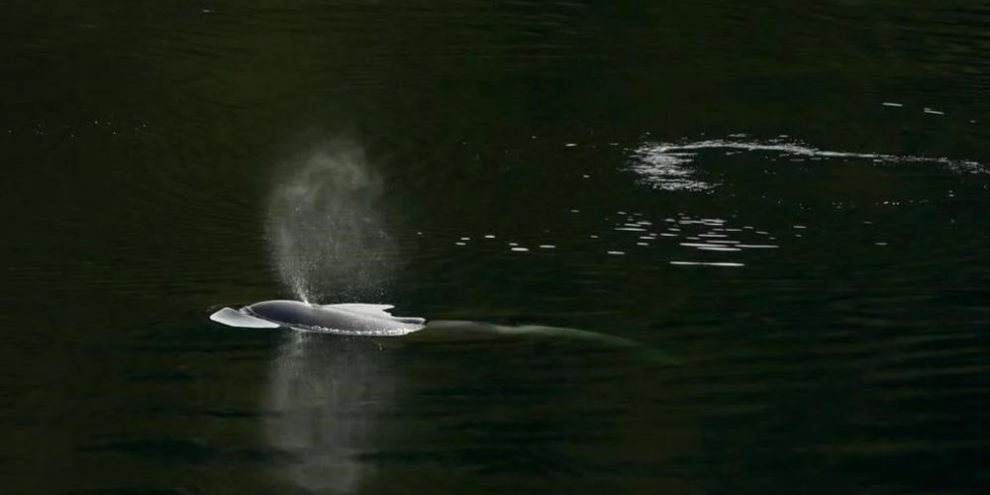
Nono Shen - The Canadian Press
A Vancouver Aquarium expert who has been involved in attempts to rescue an orphaned orca says the calf may be feeding on fish in the B.C. lagoon where she has been trapped for more than three weeks.
Veterinarian Martin Haulena said he got a good look at the calf during Friday's failed attempt to corral the whale, and she might have had been foraging, "based on her body condition being maintained."
Haulena said there were salmon, perch, ling cod and rockfish in the Vancouver Island lagoon, and while those species aren't part of the normal marine mammal diet of a Bigg's killer whale, the calf could go after them if she was hungry.
The whale has been trapped alone in the tidal lagoon near Zeballos, 450 kilometres northwest of Victoria, since March 23, when her mother became stranded and died.
“(The calf) didn’t seem to be in terrible body condition. Actually, she has been maintaining body conditions quite well. It looks like she is also quite active diving for prolonged periods of time, you know, six to eight minutes," Haulena said on Monday.
“People have offered seal carcasses, but I don’t believe anyone has actually seen her eat those,” he added, noting that a report from the Fisheries Department suggested the calf might have eaten a duck.
Barrie's News Delivered To Your Inbox
By submitting this form, you are consenting to receive marketing emails from: Central Ontario Broadcasting, 431 Huronia Rd, Barrie, Ontario, CA, https://www.cobroadcasting.com. You can revoke your consent to receive emails at any time by using the SafeUnsubscribe® link, found at the bottom of every email. Emails are serviced by Constant Contact
Haulena offered more details about Friday's failed attempt to capture the calf — which the Ehattesaht First Nation has named kwiisahi?is, meaning Brave Little Hunter — and how she outsmarted the rescue team.
The Fisheries Department said on Saturday the plan was to coax the calf into the shallows, "put her in a sling, and transfer her by truck onto a landing barge which would transport her the 19 kilometres to the open ocean for release."
Videos shared by the Fisheries Department showed the orange sling being suspended from the arm of an excavator. The process involved six vessels and up to 50 personnel, the department said.
Haulena said the process involved trying to direct the calf by banging on pipes to create loud noises underwater, as well as a series of lines suspended at regular intervals to create an underwater wall.
But the noisemakers had been used in previous unsuccessful attempts to get the young whale to swim through the channel into the lagoon.
"That did not deter her for very long," said Haulena. “It does appear like she has been getting quite used to the noise, to the boats, and the pipe.
"So, those did not deter her in the direction that folks wanted her to move."
Rescue crews have been regrouping and planning a new strategy, but Haulena said no date had been set for the next attempt.
The Fisheries Department, which has been co-ordinating the rescue with the Ehattesaht First Nation, said Monday that planning and logistics would be finalized over the next few days.
"There are a lot of moving parts to organize in such a complex operation," department spokeswoman Lara Sloan said in a statement.
Rescuers said on Friday that the change in tactics may include an attempt to capture the whale in a purse seine net in a deeper section of the lagoon.
But Fisheries Department marine mammal co-ordinator Paul Cottrell said at the time that netting would involve risks to both the calf and rescuers and needed careful planning.
University of Victoria historian Jason Colby said that in the past, aquariums had worked with purse-seine fishermen, to capture orcas. He said that because of their reliance on sonar, orcas rarely, if ever, jumped over the nets.
“But one of the challenges now is that the people who have had experience catching small cetaceans, including orcas, are not available for this operation,” said Colby, author of "Orca: How We Came to Know and Love the Ocean's Greatest Predator."
“For the people that are doing this operation … I can’t imagine a scenario in which they would have experience of catching an orca before,” said Colby.
Colby described the 2002 capture of a young orca named Springer that was thought to have been orphaned or separated from its pod when it started showing up in Puget Sound. It was successfully captured, transported to waters off B.C. and released.
Springer has since gone on to have calves of her own.
"So it was a successful operation there, this kind of thing is possible," Colby said.
He also cited the case of a small orphaned calf that was found shot in Menzies Bay, near Campbell River, B.C. A team from the Victoria aquarium Sealand of the Pacific captured her and loaded her on a truck and brought her back to the aquarium where she lived for several years.
banner image: The Canadian Press





